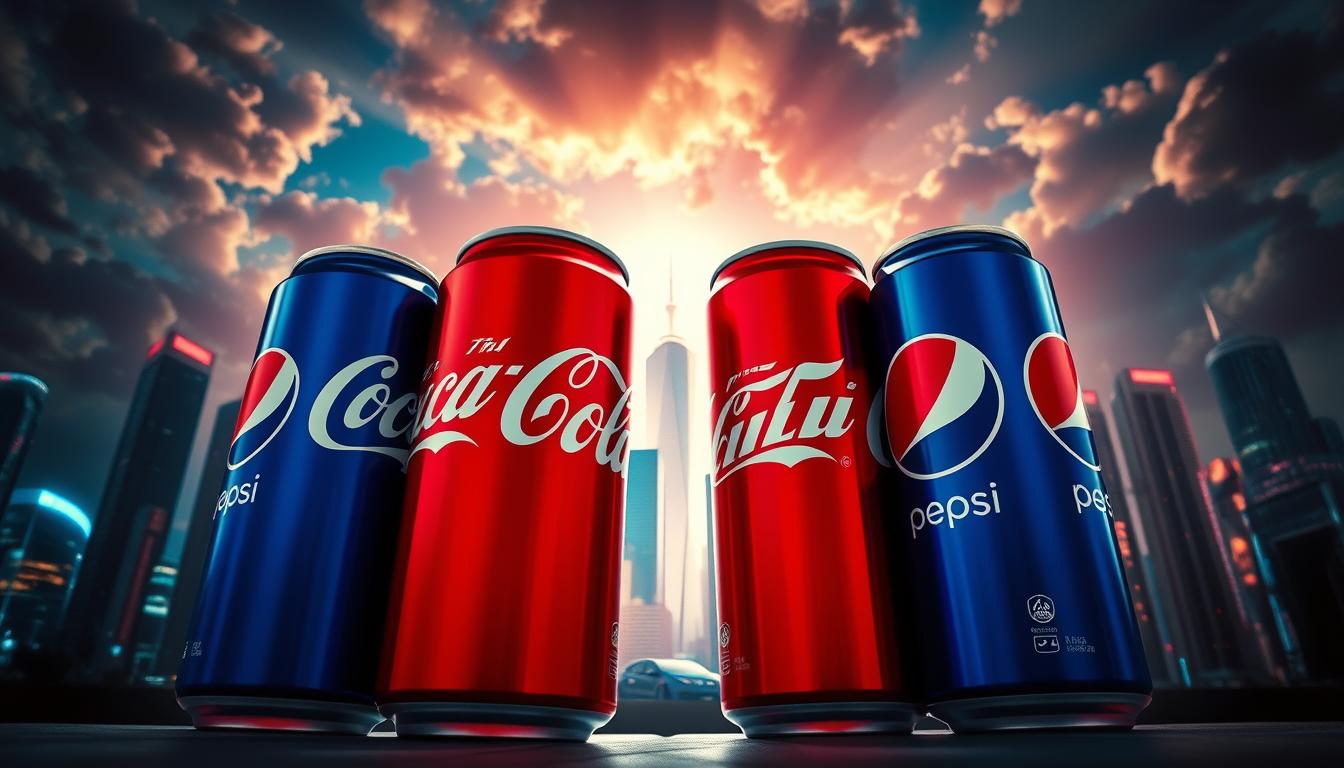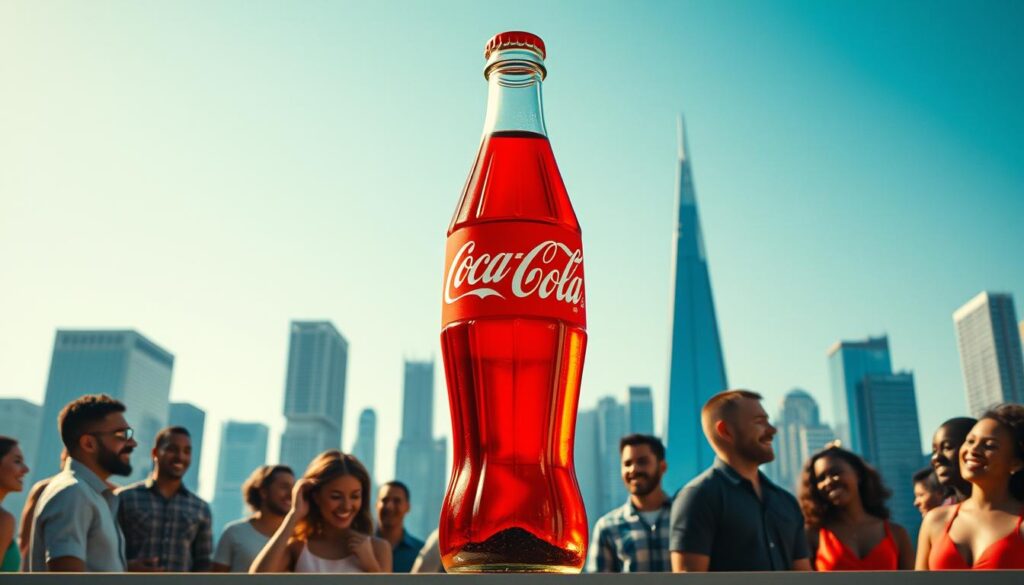Nike’s branding strategy is a masterclass in creating a brand that’s more than just a product, leveraging digital marketing and brand positioning to inspire millions. The “Just Do It” campaign has become a global movement, pushing people to achieve their goals and becoming a part of our cultural lexicon.
With 56% of surveyed customers influenced by celebrity endorsements, Nike’s marketing strategy has been gaining traction since 1984, and the “Just Do It” campaign has significantly increased brand awareness and recognition over the years, reflecting the company’s commitment to digital marketing and brand positioning.
Key Takeaways
- Nike’s “Just Do It” campaign has become a global movement, inspiring people to push beyond their limits.
- The company’s branding strategy combines digital marketing and brand positioning to create a seamless shopping experience.
- Nike uses a tiered pricing strategy, balancing accessibility and exclusivity in their product lines through effective brand positioning.
- The introduction of digital tools has increased long-term brand loyalty and community engagement, showcasing the power of digital marketing.
- Nike’s omnichannel approach ensures its products are accessible worldwide, enhancing customer engagement through digital marketing and brand positioning.
The Birth of “Just Do It”: Nike’s Marketing Revolution
Nike’s introduction of the “Just Do It” slogan in 1988 marked a significant shift in the company’s marketing strategy. This campaign, created by advertising agency Wieden+Kennedy, was designed to capture the essence of Nike’s spirit and motivate consumers to buy its products. The “Just Do It” campaign has since contributed to over 70% of Nike’s brand recognition among consumers.
The initial market response to the “Just Do It” campaign was overwhelmingly positive, with the slogan quickly becoming synonymous with Nike’s vision and mission. As the company continued to grow and expand its product lines, the “Just Do It” campaign played a crucial role in establishing Nike as a leader in the athletic apparel industry. Today, Nike is recognized as the largest athletic apparel company, dealing with footwear, accessories, and sports-related services.
The 1988 Campaign Origins
The “Just Do It” campaign was a result of Nike’s efforts to rebrand itself and appeal to a wider audience. The company’s marketing strategy focused on performance and innovation, particularly in running shoes, establishing a foundational brand association with athletics. The “Just Do It” slogan was a key component of this strategy, as it encouraged consumers to take action and push themselves to achieve their goals.
Initial Market Response
The initial market response to the “Just Do It” campaign was significant, with the slogan quickly gaining popularity among consumers. The campaign’s success can be attributed to its ability to resonate with consumers and create an emotional connection with the brand. As Nike continued to expand its product lines and marketing efforts, the “Just Do It” campaign remained a core component of the company’s brand identity.
Brand Philosophy Development
The “Just Do It” campaign played a crucial role in shaping Nike’s brand philosophy, which emphasizes empowerment, innovation, and self-expression. The company’s commitment to social media marketing and influencer marketing has also been instrumental in promoting its brand philosophy and connecting with consumers. Through its marketing efforts, Nike has been able to create a strong brand identity that resonates with consumers and sets it apart from its competitors.
Nike’s use of social media marketing and influencer marketing has been particularly effective in promoting its brand philosophy and connecting with consumers. The company has partnered with numerous influencers and athletes to promote its products and create engaging content for its social media channels. As a result, Nike has been able to build a strong online presence and create a loyal community of fans and customers.
| Year | Campaign | Impact |
|---|---|---|
| 1988 | Just Do It | Established Nike as a leader in the athletic apparel industry |
| 1990s | Social Media Marketing | Increased brand awareness and customer engagement |
| 2000s | Influencer Marketing | Expanded reach and influence among target audience |
Nike’s Traditional to Digital Marketing Evolution
Nike has undergone a significant transformation in its marketing approach, shifting from traditional methods to digital marketing strategies. This evolution has enabled the brand to reach a wider audience and create a strong online presence. With a combined audience of 360 million on social media, Nike has successfully adapted to changing consumer trends and attitudes.
The brand’s digital marketing efforts have been instrumental in driving sales growth and increasing brand awareness. By leveraging SEO strategies, Nike has improved its online visibility, making it easier for customers to find and engage with the brand. The company’s commitment to digital marketing has also led to the development of innovative campaigns, such as the “Jordan Breakfast Club,” which utilized augmented reality (AR) to enhance customer experience.
Some key highlights of Nike’s digital marketing strategy include:
* A strong social media presence, with over 150 million followers on Instagram alone
* A focus on SEO strategies to improve online visibility and drive sales growth
* The use of innovative technologies, such as AR, to enhance customer experience
* A commitment to creating engaging and interactive content, such as the “Jordan Breakfast Club” campaign
Nike’s ability to evolve and adapt to changing consumer trends has been key to its success in the digital marketing landscape. By leveraging SEO strategies and innovative technologies, the brand has been able to create a strong online presence and drive sales growth.
Building a Digital Marketing Empire Through Social Media Marketing
Nike has successfully built a massive following across various social media platforms, with a combined audience of 360 million. The brand’s social media marketing strategy focuses on creating engaging content and building a community around its brand. By leveraging social media marketing, Nike has been able to increase brand awareness, drive website traffic, and boost sales.
Through effective content marketing, Nike has been able to tell compelling stories that resonate with its audience. The brand’s use of social media platforms such as Instagram, Twitter, Facebook, and TikTok has enabled it to reach a wider audience and create a strong online presence. By sharing engaging content, such as images and videos, Nike has been able to increase user engagement and drive conversions.

Some key strategies used by Nike in its social media marketing efforts include:
- Creating engaging content that resonates with its audience
- Using social media platforms to build a community around its brand
- Leveraging influencer marketing to reach a wider audience
- Utilizing paid social media advertising to drive website traffic and boost sales
By incorporating social media marketing and content marketing into its overall marketing strategy, Nike has been able to achieve significant results. The brand’s strong online presence has enabled it to increase brand awareness, drive website traffic, and boost sales. As a result, Nike has become a leader in the digital marketing space, and its social media marketing efforts serve as a model for other brands to follow.
SEO Strategies That Propelled Nike’s Online Presence
Nike’s strong online presence can be attributed to its effective SEO strategies, which have improved its search engine rankings and driven more traffic to its website. With a combined audience of 360 million on social media, Nike has successfully leveraged digital marketing to reach its target audience.
Some of the key SEO strategies used by Nike include optimizing its website for relevant keywords, using meta tags, and creating high-quality content that resonates with its audience. By incorporating these strategies, Nike has been able to increase its online visibility and drive more sales.
Here are some benefits of Nike’s SEO strategies:
- Improved search engine rankings
- Increased website traffic
- Enhanced brand visibility
- Increased sales and revenue
Nike’s digital marketing efforts have also been successful in engaging its target audience and creating a strong brand presence online. By using a combination of SEO strategies and digital marketing tactics, Nike has been able to stay ahead of its competitors and maintain its position as a leading sports brand.
With its strong online presence and effective SEO strategies, Nike continues to be a leader in the sports industry, and its digital marketing efforts will likely remain a key factor in its success.
| Year | Revenue (in billions USD) |
|---|---|
| 2023 | 51.22 |
| 2022 | 46.77 |
The Power of Influencer Marketing in Nike’s Strategy
Nike has successfully leveraged influencer marketing to enhance its brand positioning and reach a wider audience. By partnering with athletes and celebrities, Nike has been able to promote its brand and products to a large and engaged audience. For example, Nike’s brand ambassador, who is known for running, has logged over 24,901 miles, equivalent to the circumference of the Earth, over 10 years.
In addition to partnering with high-profile athletes and celebrities, Nike has also utilized micro-influencer programs to reach a more targeted audience. Local influencers are perceived as 30% more relatable by their followers compared to global celebrities, and authentic connections with local influencers can potentially increase consumer trust and engagement rates by approximately 43%. This approach has allowed Nike to build strong relationships with its target audience and increase brand loyalty.
Nike’s influencer marketing strategy has been highly effective, with the brand reporting a 31% surge in online sales following the launch of its “Dream Crazy” campaign, featuring Colin Kaepernick. The campaign contributed to a 12% increase in brand awareness within just 6 months, and Nike’s social media engagement increased by 25% as a result of the campaign. By leveraging influencer marketing, Nike has been able to enhance its brand positioning and drive business results.
Content Marketing Mastery: Stories That Sell
Nike’s success in content marketing can be attributed to its ability to tell meaningful stories that resonate with its audience. By leveraging content marketing, the brand has been able to build a strong connection with its customers, increasing brand loyalty and engagement. According to recent statistics, 70% of marketers use content marketing as a key strategy for engaging audiences, and 53% of marketers cite blogs as the primary content format.
Effective social media marketing also plays a crucial role in Nike’s content marketing strategy. The brand uses platforms like Instagram, Twitter, and Facebook to share engaging content, including videos, images, and stories. This approach has helped Nike to increase its online presence and reach a wider audience. In fact, 87% of businesses report that video content has helped increase traffic to their website, highlighting the importance of social media marketing in content marketing.
Some key benefits of content marketing include:
- Increased engagement and brand loyalty
- Improved website traffic and online presence
- Enhanced customer experience and perception of the brand

By incorporating content marketing and social media marketing into its strategy, Nike has been able to create a strong and engaging brand identity, driving business growth and customer loyalty.
| Content Marketing Benefits | Percentage of Marketers |
|---|---|
| Increased engagement and brand loyalty | 72% |
| Improved website traffic and online presence | 87% |
| Enhanced customer experience and perception of the brand | 67% |
E-commerce Integration: Merging Brand and Sales
Nike’s e-commerce presence is a key component of its digital marketing strategy, allowing customers to purchase products online and improving customer experience. The brand’s use of e-commerce has helped drive more sales and increase brand engagement. With a strong website and mobile app, Nike has successfully integrated e-commerce into its marketing strategy, making it easy for customers to shop online and access exclusive content.
Some key benefits of Nike’s e-commerce integration include:
- Increased sales and revenue
- Improved customer experience and engagement
- Enhanced brand visibility and awareness
- Ability to collect customer data and personalize marketing efforts
Nike’s e-commerce platform is a prime example of effective digital marketing, showcasing the brand’s ability to merge sales and brand awareness seamlessly. By leveraging e-commerce marketing, Nike has been able to stay ahead of the competition and maintain its position as a leader in the sports apparel industry. The brand’s commitment to digital marketing has enabled it to connect with customers and provide a seamless shopping experience, both online and offline.
Through its e-commerce platform, Nike has been able to create a cohesive brand experience, showcasing its products and values in a way that resonates with customers. By prioritizing digital marketing and e-commerce integration, Nike has set a new standard for the industry, demonstrating the importance of a strong online presence in today’s digital landscape.
| Year | E-commerce Sales | Revenue Growth |
|---|---|---|
| 2020 | $10 billion | 20% |
| 2021 | $12 billion | 25% |
| 2022 | $15 billion | 30% |
Viral Marketing Campaigns That Changed the Game
Nike has created several viral marketing campaigns that have helped promote its brand, reaching a wider audience and driving more engagement through social media marketing. One notable example is the “Find Your Greatness” campaign, which encouraged people to share their own stories of overcoming challenges and achieving greatness.
Other successful viral marketing campaigns include the “Just Do It” slogan, which has become a rallying cry for athletes and non-athletes alike. By leveraging social media marketing, Nike has been able to create a sense of community and shared purpose among its customers, fostering brand loyalty and advocacy.
Some notable statistics from successful viral marketing campaigns include:
- Over 52 million views on YouTube for the Old Spice viral marketing video
- 10 million views and 1.4 billion people reached by Dippin’ Dots’ PR campaign
- 8,000% increase in brand mentions on Twitter for Dippin’ Dots
These campaigns demonstrate the power of viral marketing and social media marketing in creating engaging content that resonates with audiences and drives brand awareness.
| Campaign | Views | Reach |
|---|---|---|
| Old Spice | 52 million | 1.4 billion |
| Dippin’ Dots | 10 million | 1.4 billion |
Email Marketing Innovation: Personal Touch at Scale
Nike’s email marketing strategy is a prime example of how to create a personal touch with customers at scale. By leveraging segmentation and personalization techniques, Nike is able to tailor its email marketing campaigns to individual customers, resulting in higher engagement and conversion rates.
Some key statistics that demonstrate the effectiveness of email marketing include:
- Email marketing has an average ROI of $42 for every $1 spent
- Personalized emails can improve click-through rates by up to 14% and conversion rates by 10%
- Segmented campaigns can lead to as much as a 760% increase in revenue
By incorporating digital marketing strategies, such as automation and personalization, into its email marketing campaigns, Nike is able to create a more personalized and engaging experience for its customers. This approach has helped Nike to build strong relationships with its customers and drive business growth.

As the global email marketing market continues to grow, it’s clear that email marketing is a crucial component of any digital marketing strategy. By leveraging the power of email marketing, businesses like Nike can create a personal touch with their customers at scale, driving engagement, conversion, and revenue growth.
| Statistic | Value |
|---|---|
| Average ROI for email marketing | $42 for every $1 spent |
| Increase in click-through rates with personalized emails | Up to 14% |
| Potential increase in revenue with segmented campaigns | Up to 760% |
Paid Advertising Success: Maximum ROI Through Strategic Placement
Nike’s success in paid advertising can be attributed to its strategic placement, driving more traffic to its website and improving its return on investment (ROI). By leveraging digital marketing channels, Nike has been able to reach a wider audience and increase sales.
Some key benefits of paid advertising include:
- Measurable outcomes, enabling tracking of conversion lift and overall campaign performance
- Precision targeting, boosting engagement and customer retention rates by reaching specific audiences
- Retargeting strategies, increasing conversion rates by keeping brand messaging in front of users who have already expressed interest
According to recent statistics, the average ROI for Google Ads is reported to be $8 for every $1 spent, while PPC advertising typically yields an average return of $2 for every $1 spent. By incorporating paid advertising into its digital marketing strategy, Nike has been able to maximize its ROI and drive business growth.
By understanding the importance of strategic placement and leveraging the benefits of paid advertising, businesses like Nike can achieve significant returns on their digital marketing investments. As the digital landscape continues to evolve, it’s essential for companies to stay ahead of the curve and optimize their paid advertising campaigns for maximum ROI.
Measuring Success: Key Performance Indicators and Growth Metrics
To understand how Nike measures success, we need to look at the key performance indicators and growth metrics they use. This includes digital engagement metrics and revenue impact analysis, which help the brand improve its marketing strategy. By analyzing these metrics, Nike can identify areas of strength and weakness, and make data-driven decisions to optimize their marketing efforts.
Nike’s use of digital marketing and SEO strategies has been instrumental in their success. By tracking metrics such as website traffic, social media engagement, and conversion rates, Nike can see how their marketing efforts are paying off. This information is then used to refine their strategy, making adjustments as needed to ensure they are meeting their goals.
- Website traffic and engagement
- Social media metrics, such as followers and engagement rate
- Conversion rates and revenue growth
- Customer acquisition and retention rates
By tracking these metrics, Nike can get a clear picture of how their marketing efforts are impacting their business. This information is then used to inform future marketing decisions, ensuring that Nike continues to drive growth and success.
As a result of their focus on digital marketing and SEO strategies, Nike has seen significant growth and success. Their ability to measure and analyze their marketing efforts has allowed them to make data-driven decisions, optimizing their strategy and driving results. By following Nike’s example, other businesses can also achieve success in the digital marketplace.
Conclusion: Lessons from Nike’s Digital Marketing Mastery
As we’ve seen, Nike’s digital marketing strategy has been a game-changer, driving the brand’s remarkable success in the modern era. From leveraging social media platforms like Instagram, Twitter, and TikTok to implementing influencer collaborations and content marketing mastery, Nike has truly excelled at adapting to the ever-evolving digital landscape.
The key lessons brands can learn from Nike’s digital marketing prowess include the importance of building a strong online presence, fostering authentic connections with consumers through engaging content, and strategically aligning with influential voices that resonate with the target audience. Nike’s ability to seamlessly integrate its brand identity across various digital touchpoints has been a hallmark of its marketing strategy.
By emulating Nike’s data-driven approach to measuring success through social media metrics, revenue impact, and brand value evolution, other companies can optimize their own digital marketing efforts for maximum return on investment. The sports giant’s continued innovation in areas like personalized experiences and mobile app development further underscores the value of embracing a customer-centric mindset in the digital age.
Ultimately, Nike’s digital marketing mastery serves as a testament to the power of adaptability, creativity, and a relentless pursuit of connecting with consumers in meaningful ways. As brands strive to navigate the ever-changing digital landscape, the lessons learned from Nike’s success can serve as a blueprint for achieving lasting impact and growth.
FAQ
What is the "Just Do It" campaign and how has it become an iconic part of Nike’s branding strategy?
The “Just Do It” campaign has become a global movement that inspires people to push beyond their limits and achieve their goals. The slogan has become a part of our cultural lexicon, and its impact on Nike’s success cannot be overstated.
How did the "Just Do It" campaign originate and what was the initial market response?
The “Just Do It” campaign was designed to capture the essence of Nike’s spirit and motivate consumers to buy its products. The campaign’s origins and initial market response will be discussed, as well as how it influenced Nike’s marketing strategy.
How has Nike evolved from traditional to digital marketing?
Nike has adapted to changing consumer trends and attitudes, and has created a strong online presence through digital marketing and social media. This section will examine how the brand has transitioned from traditional to digital marketing.
How has Nike built a digital marketing empire through social media marketing?
Nike’s social media strategy, including its presence on platforms like Instagram, Twitter, Facebook, and TikTok, will be examined. The brand’s use of social media to create engaging content and build a community around its brand will be discussed.
What SEO strategies have propelled Nike’s online presence?
This section will explore how Nike uses keywords, meta tags, and other SEO techniques to improve its search engine rankings and drive more traffic to its website.
How does Nike leverage influencer marketing as part of its strategy?
Nike’s partnerships with athletes and celebrities, as well as its micro-influencer programs, will be examined to understand how the brand uses influencer marketing to promote its brand.
How does Nike’s content marketing strategy create meaningful stories?
This section will discuss how Nike creates engaging content that tells meaningful stories, and how it uses storytelling to build a strong connection with its audience.
How does Nike integrate e-commerce into its marketing strategy?
The integration of e-commerce into Nike’s marketing strategy, including its website and mobile app, will be examined. The brand’s use of e-commerce to drive more sales and improve customer experience will be discussed.
What are some of Nike’s viral marketing campaigns that have changed the game?
This section will explore how Nike creates viral content that resonates with its audience, and how it uses social media to promote its campaigns.
How does Nike use email marketing to create a personal touch with its customers?
Nike’s use of email marketing, including its segmentation and personalization techniques, will be examined to understand how the brand creates a personal touch with its customers at scale.
How does Nike use paid advertising to drive traffic and improve ROI?
This section will discuss how Nike uses paid advertising to drive more traffic to its website and improve its ROI, including its use of strategic placement.
How does Nike measure the success of its digital marketing strategies?
Nike’s use of digital engagement metrics and revenue impact analysis to measure the success of its marketing strategies will be discussed, and how the brand uses this data to improve its marketing strategy.





